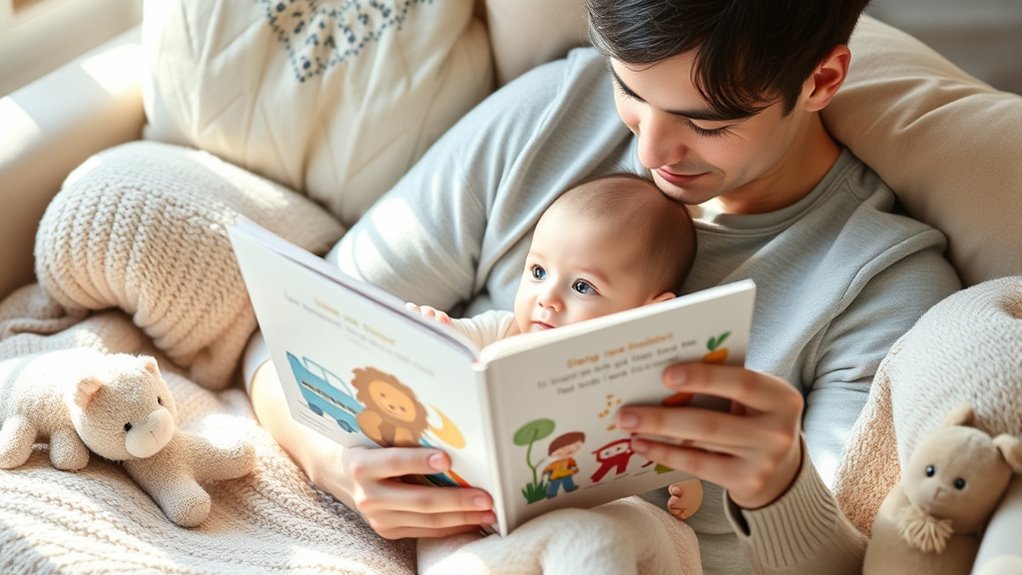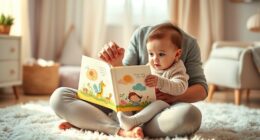Bilingual storytelling exposes your baby to two languages at once, supporting early language skills and cultural awareness. By sharing stories in both languages, you help your child recognize sounds, words, and sentence structures, making language learning enjoyable and natural. It also introduces them to diverse cultures and traditions, fostering curiosity and respect. This approach promotes bonding and strengthens your child’s confidence in their cultural identity. Keep exploring to discover how this method benefits your child’s overall development.
Key Takeaways
- Bilingual storytelling enhances early language skills by exposing babies to sounds, words, and sentence structures in two languages simultaneously.
- It introduces diverse cultural stories, fostering curiosity, respect, and understanding of different traditions from a young age.
- Reading in two languages improves a baby’s listening, comprehension, and ability to switch between languages naturally.
- Shared bilingual reading creates bonding moments, making language learning engaging and boosting confidence in both languages.
- Overall, it supports holistic development—linguistic, cultural, and social—by nurturing multilingualism and cultural awareness from infancy.

Have you ever wondered how storytelling can bridge language gaps and enrich cultural understanding? Introducing your baby to stories in two languages is a powerful way to do both. When you read bilingual stories aloud, you’re not just sharing a simple narrative—you’re laying the foundation for your child’s language development and fostering their cultural awareness. As your voice brings characters to life in two languages, your little one begins to recognize sounds, words, and sentence structures, which boosts their ability to understand and eventually speak both languages more fluently.
Bilingual storytelling helps your baby develop an ear for different sounds, intonations, and rhythms. This practice enhances their language development because exposure to multiple languages during early childhood is linked to better phonetic discrimination and vocabulary growth. The more you read in two languages, the more your baby internalizes the unique patterns of each tongue, making it easier for them to switch between languages naturally later on. It’s like giving their brain a workout in multilingual listening and comprehension, setting a strong foundation for future language mastery.
Moreover, reading bilingual stories nurtures cultural awareness, which is just as important as linguistic skills. When you include stories from different cultures, you’re exposing your child to diverse traditions, values, and worldviews. This grows their curiosity and respect for others, helping them see the world as a bigger, richer place. As you read stories that highlight customs, holidays, or folklore from different backgrounds, you’re instilling a sense of openness and appreciation for cultural differences. This early exposure encourages your child to embrace diversity, fostering empathy and global-mindedness from a young age.
Using bilingual storytelling also creates meaningful bonding moments between you and your baby. It’s an interactive experience where you can point out words, gestures, and expressions in both languages, making the story more engaging and memorable. These shared moments reinforce your child’s confidence in their language abilities and help them feel proud of their cultural heritage. Plus, it can make learning multiple languages feel natural and enjoyable rather than intimidating.
In essence, reading stories in two languages isn’t just about language; it’s about shaping a well-rounded, culturally aware individual. It’s a simple yet impactful way to nurture your child’s language development while opening their eyes to the beauty of different cultures. As you continue this practice, you’re not only enriching their vocabulary and comprehension skills but also planting seeds of cultural understanding that will grow throughout their lives.
Frequently Asked Questions
How Early Can I Start Bilingual Storytelling With My Baby?
You can start bilingual storytelling as early as infancy, even before your baby talks. Early language exposure helps build a strong foundation for future learning. Incorporate reading routines that include two languages, making it a natural part of daily life. Use simple, engaging stories in both languages, and your baby will enjoy the sounds and rhythms, fostering bilingual development and strengthening your bond through shared reading experiences.
What Are the Best Books for Bilingual Storytelling?
Picking perfect bilingual books promotes playful, purposeful learning. You should seek stories that spark curiosity, showcasing simple sentences and vibrant visuals. These books boost cultural exposure, introduce diverse traditions, and enrich vocabulary. Look for bilingual picture books, folktales, and rhymes that seamlessly blend both languages. Your choice of engaging, enriching stories will nurture your baby’s language skills and cultural understanding, creating a mesmerizing, colorful foundation for lifelong learning.
How Do I Balance Two Languages During Reading Sessions?
To balance two languages during reading sessions, you can use code-switching strategies, alternating between languages seamlessly to keep your baby engaged. Incorporate cultural language integration by selecting books that highlight both languages and cultural themes, fostering understanding and respect. Be consistent, but flexible; switch languages naturally based on context or your child’s cues. This approach helps your baby develop bilingual skills while appreciating both cultures.
Can Bilingual Storytelling Affect My Child’s Language Development?
Imagine opening a treasure chest of language exposure for your little one. Bilingual storytelling gently boosts their cognitive benefits, enriching their understanding of different words and sounds. It’s like giving your child a head start in a global world, fostering flexibility and problem-solving skills. With consistent, joyful reading, you’ll see their language development blossom, making them more confident and curious about the diverse world around them.
Should I Switch Languages When Reading to My Baby?
You might wonder if switching languages when reading to your baby is beneficial. While maintaining language consistency can help with early understanding, switching languages can boost cultural exposure and bilingual skills. It’s okay to alternate languages, especially if your goal is to expose your child to multiple cultures. Just guarantee that each language is used consistently enough for your baby to grasp and enjoy the stories, fostering both language development and cultural awareness.
Conclusion
Bilingual storytelling isn’t just about language; it’s about building a bond and sparking curiosity in your baby. When you read in two languages, you help develop their brain and cultural awareness simultaneously. The rhythm of switching between languages can become a comforting pattern, making reading time special. Trust that your efforts are shaping a confident, multilingual little one. Keep sharing stories—your voice and these moments create a lifelong love of learning.










